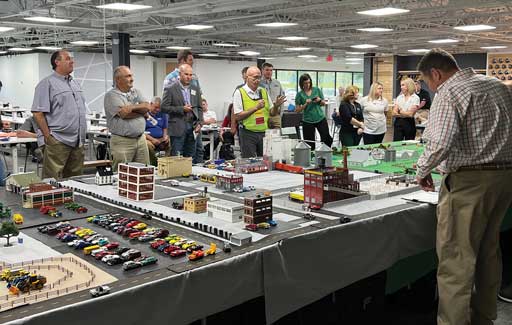
Coming together as an industry to practice and test a response plan is a critical component of foreign animal disease (FAD) preparation. Simulated situations and guided discussions highlight areas of preparation for both farmers and veterinarians. Dr Patrick Webb, assistant chief veterinarian for National Pork Board (NPB), along with his colleague Bruce Spence, has executed more than 150 tabletop exercises over 20 years.
“The original intent was to raise awareness for key stakeholders and drive action for producers,” explained Webb. “Throughout the years and especially since African swine fever (ASF) emerged in China in 2018, there has been a lot of planning for an FAD outbreak. It is great on paper, but until you experience it, you do not know if the plan is workable.”
A recent tabletop focused on the show pig community. Everyone was assigned a section of the table to manage. These simulated activities demonstrate a mix of facilities including a packing plant, sow farm, wean-to-finish operation, feed mill, fairgrounds, or dairy and beef farms. The people managing these realistic entities needed to respond and operate in a confirmed FAD outbreak.
“The cardinal rule of emergency planning is you must have more than one plan for every situation,” warned Webb. “There will not be enough resources for every producer, so it will be up to producers and their veterinarians to make a suitable plan for their operation, and then adapt as needed.”
In tabletop exercises, each group develops an operational plan, submits their plan for approval, and seeks supplies. However, if supplies are not available, adjustments are mandatory. Webb describes these activities as a “fog of war” with so many decisions and potential obstacles, but it also approximates the need for an emergency operations center and reaffirms that producers and veterinarians need to be part of the FAD response.
“As swine veterinarians, we are often immersed in FAD discussions, but many producers, especially those in show pig and niche production, have not been quite as involved in those discussions,” said Dr Amy Woods, veterinarian with AMVC Swine Health Services.
Scenarios given at the June tabletop included an outbreak at fairgrounds, impacting the show pig community who frequently travel to different states. “This exercise was also extremely beneficial in fostering the relationship between NPB and the show pig industry, bridging the gap in communication and understanding between the show pig and commercial industries. Those two sectors have very different business purposes and goals. However, we need to determine how to work together for common industry goals during animal health emergencies,” Woods continued.
A veterinarian’s role during an FAD response may vary depending on their type of veterinary practice and the types of farm operations they serve. For example, animal health staff in an integrated system will focus on their pigs and contract farmers, while veterinarians with clients may have different roles and responsibilities with multiple production systems or independent operations.
“When we first started these exercises, business continuity was not part of the discussion,” Webb reflected. “With the good things the Pork Checkoff has done, we now have tools giving people hope.” Tools used in an outbreak include AgView, an opt-in, pig contact-tracing technology funded by Pork Checkoff. The tabletop exercises allow participants to practice using AgView and see its value firsthand. Plus, tools are developed or enhanced because of knowledge gaps identified and situational analyses, which are valuable outcomes of these exercises.
Visit porkcheckoff.org for more information about the industry’s commitment to FAD prevention, preparedness, and response.
